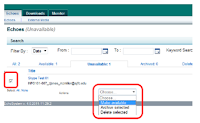iCloud stores your music, photos, documents, and
more. Pushes them to all your
devices and automatically keeping everything up to date.
iCloud features: http://www.apple.com/icloud/features/
- iTunes in the Cloud- music purchased in iTunes appears automatically on all devices.
- Photo Stream- take a photo on one device, automatically appears on all devices.
- Documents in the Cloud- iCloud enabled apps on more than on device, iCloud will automatically keep your documents up to date across all devices.
- Apps, Books, and Backup- make sure all devices have the same apps and books. Also backs up your information.
- Calendar, Mail, and Contacts- stores calendar, mail, and contacts and automatically pushes them to all your devices.
- Find My iPhone- sign into icloud.com or use the app from another device to find your missing device.
-
From Safari- tap the Bookmarks icon , and tap the iPad User Guide from the list.
Bookmark icon - Add icon for user guide to Home Screen- tap the arrow pointing to the right , and then tap Add to Home Screen.
 |
| Arrow icon |
- From iBooks- open iBooks and tap Store. Search for iPad User Guide, select IO S 5
(latest) and tap Get Book. This will open the iPad User Guide within iBooks.
Organizing w/folders
Folders can be used to organize icons on the Home screen. You can put up to 20 icons in a folder.- Create a folder- press and hold an icon until the icons begin to jiggle, drag the icon onto another icon. You can tap the name field to re-name the folder.
- When finished organizing your Home screen, click the Home button to save the changes.
Access all running apps
Double-click the Home button will display all the apps that are running on your iPad in the bar at the boom of the screen. To switch to a running app, tap on it from the bar. Lock screen
Lock the screen orientation or use music controls- double-click the Home button, flick along the bottom of the screen. The screen orientation lock, brightness slider, and music controls will appear.
iPad2 gestures
- Use four or five fingers, swipe up to reveal the multitasking bar, pinch to return to the Home screen.
- Swipe left or right to switch between apps.
The Notification
Center displays all your alerts in one place. Swipe down from the top of the screen to show
the Notification Center.
- Respond to an alert- tap the alert from the Notification Center or swipe the alert from left to right to respond to an alert on the lock screen.
- Remove an alert- Tap the and tap Clear.
- Set up options for notifications- Settings> Notifications.
Typing
- Quickly type a period– double tap the Space bar.
- Turn caps lock on – Double-tap the Shift key.
 |
| Shift key |
- Find a definition or alternative words – tap a word to select it, tap Dictionary or Suggest.
- Shake iPad, or tap undo on the keyboard.
 |
| Shake iPad to undo |
- Cut, Copy, Paste- touch a word and hold it until the magnifying glass comes out. Left go and the will with be highlighted including two pull bars on both ends. Tap the "Copy" bubble or drag the handles to highlight more words. Tap the location you want to past onto, touch and hold and the "Paste" icon comes out. If using the keyboard bring up the "Select" and "Select All" command.
- Press ".?123" key, a another set of virtual keyboard buttons including the "undo " button.
- Press "#+=" key, a another set of virtual keyboard buttons including the "redo" button.
- Split keyboard- touch and hold the Keyboard button , slide finger to Split and release.
- Move keyboard-touch and hold the Keyboard button , slide finger to Undock to move the keyboard to the middle of the screen and release. Return to full keyboard-touch and hold the Keyboard button , slide finger to Dock and Merge and release.
 |
| Split iPad keyboard image |
How can I take a screen shot from my iPad? Yes
It takes two button presses! First, hold the power button on the upper right hand side of the iPad and then pre the "Home" button. (main button on the middle lower part of the iPad screen)
My iPad keeps freezing, what do I do?
In most cases, a "hard reset" fixes most issues. It takes two button presses to do a hard reset.
Press and hold the Power/Sleep/Wake button on the upper right of your iPad along with the Home button on the middle lower part of the iPad screen. After 10 seconds, you should see the Apple logo. That is the sign that you've successfully completed a hard reset.
Protecting you data is always a good idea!
A passcode is a security feature to help protect the
information on the iPad from being accessed by others.
- Set a passcode- Settings> General> Passcode Lock> Turn Passcode On, enter a 4-digit passcode and verify. More information on Auto-Lock page 123 of iPad User Guide.
- From the Settings menu>General>About> Name
Additional App Resources:
Check out my review of the newest iPad (3)Free Math Apps By Grade Level, via Tutor House











